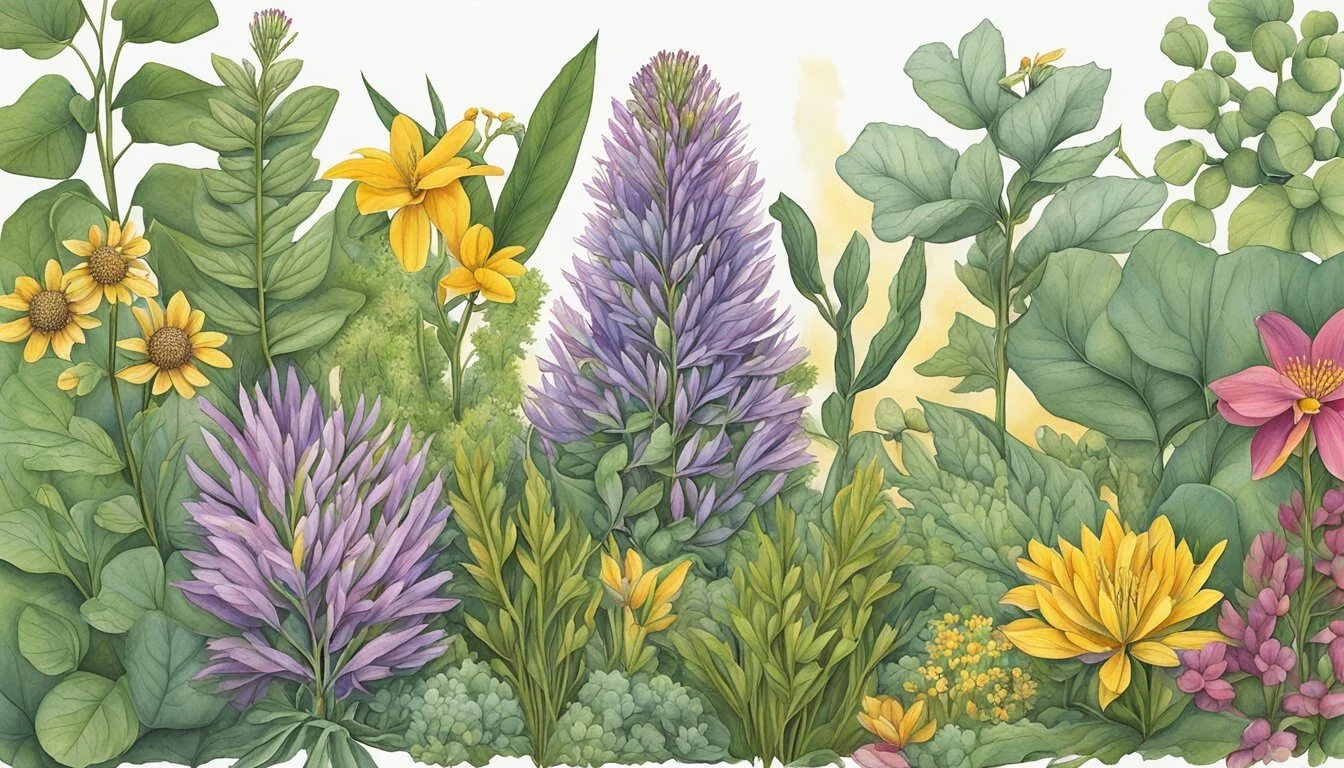Native Edible Plants in Oklahoma
A Guide to Foraging and Cooking
This Article is Part of Foraging Guide for All 50 US States
Oklahoma's diverse ecosystems, ranging from arid plains to lush forests, are home to a variety of native edible plants. These local species not only offer a glimpse into the region's botanical heritage but also provide opportunities for foraging. Engaging in the collection and consumption of these plants connects individuals with the land and can serve educational purposes, enhancing understanding of the local environment and traditional culinary practices.
Foraging for edible plants in Oklahoma requires knowledge of the regional flora. It is essential for foragers to be able to identify these plants accurately to ensure safety and sustainability. Among the notable native species are the sand plum, also known as Chickasaw plum, Pawpaw, and the wild onion. These plants are not just survivors in the Oklahoman climate but are a testament to the rich biodiversity of the state.
When exploring Oklahoma's native edible plants, it's important to consider the legal and ethical implications of foraging. Sustainable harvesting practices are critical to maintaining the balance of these ecosystems. Additionally, foragers are advised to seek permission before collecting plants on private lands and to follow state guidelines to protect both the environment and the foraging community.
Interested in Mushroom Hunting in Oklahoma?
Oklahoma's diverse landscapes, from forests to prairies, offer a variety of edible mushrooms. Morels, chanterelles, and chicken of the woods are among the most sought-after species. With proper identification skills and respect for public and private land regulations, mushroom hunting in Oklahoma promises a rewarding and enjoyable experience.
👉 Guide on Mushroom Hunting in Oklahoma
Understanding the Oklahoma Ecosystem
Oklahoma's ecosystem is a rich tapestry of habitats and biodiversity, shaped by its climate and the interplay of environmental elements. This complex network sustains a variety of native plants vital to the state’s natural heritage and wildlife.
Importance of Native Plants
Native plants are crucial to the health and stability of ecosystems. In Oklahoma, they support local wildlife, including pollinators and other beneficial insects, by providing food and habitat. The deep root systems of native prairie plants, for example, play an essential role in soil conservation and water management, helping to prevent erosion and maintain water quality.
Key Contributions of Native Plants:
Soil stabilization
Water conservation
Support for local wildlife
Oklahoma's Diverse Habitats
Oklahoma is characterized by its diverse range of habitats, each with distinct climate conditions and supported flora and fauna. The state spans from the moist Eastern temperate forests to the arid Western high plains, embracing an extensive central grassland core. These habitats form a unique convergence zone for both wildlife and plant species.
Oklahoma Habitat Types:
Temperate Forests: Deciduous woodland canopies create a moist, cool climate for a diverse understory.
Central Grasslands: Dominated by tall and short prairie grasses, accommodating distinct prairie ecosystems.
Prairie and Plains: These are vast swathes of open land where grasses, herbs, and occasional trees thrive.
By fostering an appreciation and deeper awareness of Oklahoma's ecosystems and their native plants, conservation efforts can be enhanced to preserve this region's natural resources for generations to come.
Foraging Fundamentals
In Oklahoma, foraging for wild edibles requires an understanding of safety protocols, refined techniques, and adherence to local legal guidelines to ensure a rewarding experience.
Safety and Ethical Considerations
When foraging, one's safety is paramount. Misidentification can lead to ingestion of toxic plants with dire consequences. Therefore, it's essential that foragers:
Carry a field guide or use a smartphone app for accurate plant identification.
Never consume a plant unless they are 100% certain of its edibility.
Foragers should also practice ethical foraging by:
Only taking what they need to avoid depleting natural resources.
Harvesting in a way that allows plants to regenerate.
Foraging Techniques
Effective foraging techniques vary depending on the plant species and habitat. Novices should consider these tips:
Start with easily recognizable and abundant plants.
Learn the habitats where edible plants are likely to flourish.
To avoid damaging plant populations, one should:
Forage in areas with plentiful plants.
Use tools like knives or scissors to cut rather than uproot.
Legal Aspects of Foraging in Oklahoma
Legalities must be observed to forage responsibly in Oklahoma. Foragers must:
Obtain permission from private landowners to forage on their land.
Adhere to public land regulations that may limit or prohibit foraging activities.
The following table summarizes key points:
Consideration Description Plant Identification Use guides to be certain of edibility and avoid toxic plants. Harvesting Quantity Take only needed amounts, ensuring sustainability. Tools for Harvesting Use appropriate tools to minimize harm to plants. Land Permissions Always get permission and follow public land rules.
Foragers should stay informed of local legislative changes to remain compliant.
Notable Edible Plants in Oklahoma
Oklahoma's diverse ecosystems provide a rich array of plants with edible parts ranging from fruits and berries to roots and greens. These plants have been used for centuries by Native American tribes and continue to be a valuable resource today.
Edible Fruits and Berries
Blackberries (Rubus spp.): Thriving in the wild, they produce ripe, juicy berries during late spring to early summer.
Persimmon (Diospyros virginiana): Native persimmons, with their sweet, honey-like flavor, are ready for harvest in late fall.
Peaches (Prunus persica): Although not native, peaches have been naturalized and can be found in abandoned farmsteads and homesteads.
Apples (Malus domestica): Similar to peaches, apples aren’t native but are commonly found where they’ve escaped cultivation.
Mulberries (Morus rubra): These trees are common in Oklahoma and bear fruit that resembles a long, slender blackberry.
Beneficial Herbs and Greens
Dandelion (Taraxacum officinale): Every part of this plant is edible; the leaves can be used in salads or cooked, and the roots can be roasted for a coffee substitute.
Ramps (Allium tricoccum): Known for their strong onion-garlic flavor, ramps are often used to flavor dishes and can be found in wooded areas.
Violet (Viola spp.): The flowers and leaves are both edible, with the leaves adding a subtle flavor to salads.
Watercress (Nasturtium officinale): Typically found in running water, it's a peppery green that’s high in nutrients.
Roots, Tubers, and Rhizomes
Jerusalem Artichoke (Helianthus tuberosus): Also known as sunchoke, this tuber can be eaten raw or cooked with a texture similar to potatoes.
Ramps (See "Beneficial Herbs and Greens" section): The bulbs of ramps can be used like onions and have a pungent, savory taste ideal for culinary uses.
Profile of Select Native Edibles
This section explores a selection of plants native to Oklahoma, revered for their edibility and historical significance in local diets.
Pawpaw: America's Forgotten Fruit
The Pawpaw (Asimina triloba) is a unique fruit-bearing plant indigenous to Oklahoma's diverse ecosystems. Often overshadowed by widespread fruits, the Pawpaw has a rich custard-like flavor, drawing comparisons to bananas and mangos. It thrives in the understory of hardwood forests, with large, simple leaves and edible, nutritious fruits that ripen to a yellowish-green.
The Versatile Prickly Pear
Prickly Pear (Opuntia spp.) is a cactus species found across Oklahoma, resilient and adaptable to arid environments. Its paddle-shaped pads are known as "nopales" and are commonly consumed when tender and young, while its fruits, or "tunas," offer a sweet-tart flavor. Prickly Pear is not only a culinary asset but also a source of water efficiency in landscaping.
Edible Parts
Nopales (pads): Cooked similarly to vegetables
Tunas (fruit): Consumed raw or in jellies
Wild Onions: A Staple for the Ages
Wild Onions (Allium spp.) grow abundantly in the fields and woods of Oklahoma and have been a cornerstone in local cuisine for centuries. These flavorful bulbs were traditionally gathered by Native American tribes as one of the first signs of spring. Their culinary versatility makes them an essential flavoring agent in a multitude of dishes.
Culinary Uses
Fresh: Used to add a punch to salads and sandwiches
Cooked: Sautéed as a side dish or integrated into soups
Wild Onions coexist with other native plants such as Cattails, Squash, Okra, and Blueberries, which are also appreciated for their edibility. Cattails, typically found in wetlands, offer multiple edible parts from their shoots to their pollen. Tomatoes, though not native, have become a staple crop whereas native Squash varietals and Okra thrive in Oklahoma's climate. Blueberries, enjoyed for their sweet, tangy berries, grow in the acidic soils of the state's forests.
Plant Identification and Field Guides
Successful plant identification is essential for anyone interested in foraging for native edible plants. This section offers guidance on distinguishing edible plants, utilizing field guides, and understanding the importance of botanists in the context of plant identification.
Key Characteristics of Edible Plants
Identifying edible plants such as Tradescantia ohiensis, Tradescantia tharpii, and Tradescantia ozarkana requires recognition of specific characteristics. Leaf shape, stem texture, and flower color are vital clues. For instance:
Tradescantia ohiensis: lance-shaped leaves, blue to purple flowers.
Tradescantia tharpii: shorter plants with fewer branches, yellow stamen hairs.
Tradescantia ozarkana: prefers rocky woodlands, petals often rose to purple tints.
When examining plants, one should also look for patterns in growth habit and fruiting bodies as these aspects can greatly aid in accurate identification.
Using Field Guides Effectively
Field guides are invaluable resources for both novices and seasoned botanists. To use a field guide effectively, one should:
Start with a clear photo or sketch of the plant in question.
Compare the image with illustrations or photographs within the guide.
Read the descriptions thoroughly; they often include details not evident in pictures.
Utilize dichotomous keys provided in the guide by following step-by-step questions leading to identification.
Using a combination of visual and textual information will enhance the accuracy of plant identification.
The Role of a Botanist
Botanists play a pivotal role in the realm of plant identification. They:
Conduct research that leads to a deeper understanding of plant characteristics.
Publish field guides and scientific papers that assist others in identifying plants.
Provide expert opinions on ambiguous cases where traditional field guides may not suffice.
By engaging with a botanist's work, one can gain insights into the subtle distinctions between similar species, such as Tradescantia varieties, which are crucial for safe and successful foraging of edible plants.
Culinary Uses of Wild Edibles
Wild edibles in Oklahoma offer a vast array of flavors and nutritional benefits, widely used in both traditional and contemporary cuisines. These plants are often rich in iron, fiber, and vitamins A and C, contributing to a well-rounded diet.
Traditional Native American Uses
Native American culinary practices have long embraced the natural bounty of Oklahoma's flora. For instance, wild greens are often harvested and cooked as part of traditional dishes, thereby providing essential vitamins and fiber. Teas made from local herbs not only hold medicinal properties but also serve as a vital source of vitamin C. A popular beverage is sumac lemonade, made by steeping the drupes of the sumac to create a drink rich in vitamin A and C, with a tart flavor reminiscent of lemonade.
Pawpaw: consumed fresh or added to foods
Persimmon: turned into puddings or bread
Wild onions: utilized in savory dishes
Modern Kitchen Applications
Today, chefs and home cooks alike are finding innovative ways to incorporate wild edibles into modern dishes, often driven by the desire for fresh, local, and nutritious ingredients. Many plants can be pickled, offering a tangy twist to salads and sandwiches. Chefs create infusions and sauces, utilizing the high vitamin C content and bright flavors reminiscent of citrus, such as in the case of sumac lemonade. Foraging for edibles adds not only nutrition to the plate but also an element of local terroir.
Salads: featuring wild greens for a nutrient boost
Soups: with a base of foraged herbs, and wild onions
Tea infusions: serving as both healthful beverages and flavorful broth bases
Health Benefits and Nutritional Value
Native edible plants in Oklahoma offer an array of health benefits and are rich in vitamins and minerals. These plants include both commonly recognized edibles and those traditionally used for medicinal purposes.
Medicinal Plants and Native Remedies
Medicinal plants native to Oklahoma have been used by indigenous populations for centuries to treat a variety of ailments. Echinacea purpurea, also known as purple coneflower, is utilized for its immune-boosting properties. Symphyotrichum oblongifolium, or the aromatic aster, is used for its antifungal and antibacterial characteristics. These native species continue to be relevant in natural remedy circles today.
Vitamin and Mineral Profiles of Native Edibles
The nutritional value of Oklahoma's native edibles is quite diverse. Below are profiles of select plants highlighting their vitamin and mineral content:
Amaranth (how long does amaranth last?) (Amaranthus spp.): A powerhouse of nutrients, amaranth leaves are high in vitamins A, C, and B6, as well as calcium, iron, and magnesium.
Pawpaw (Asimina triloba): Known for its fruit, pawpaw contains vitamin C, magnesium, and several B-complex vitamins.
Wild Onion (Allium canadense): Often used in traditional dishes, wild onions are a good source of vitamin C, dietary fiber, and small amounts of iron and calcium.
These plants contribute significantly to a balanced diet and support overall health when incorporated into regular meals.
Incorporating Wild Edibles into Home Gardening
Gardeners in Oklahoma can enhance their home gardens by introducing native edibles, which often require less maintenance than traditional garden plants due to their adaptation to the local climate and soil. Including these plants supports ecological gardening practices by promoting biodiversity and conserving water.
Step-by-Step Guide to Integrating Native Edibles:
Research:
Begin with understanding the native species that are edible. Local extension services or native plant societies are excellent resources.Selection:
Choose plants based on your garden's specific conditions – soil type, sun exposure, and moisture level.Suitable Native Plants Description Pawpaw (Asimina triloba) A small tree producing custard-like fruits. Wild Onion (Allium canadense) Edible bulbs and leaves, similar to cultivated onions. Sand Plum (Prunus angustifolia) Small plums for jams or fresh eating.
Design:
Integrate native edibles aesthetically with other landscape elements. For instance, the attractive blossoms of sand plum can enhance the visual appeal of the garden.Soil Preparation:
Amend your garden soil only if necessary. Native plants typically thrive in their natural soil conditions.Planting:
Plant in the appropriate season for best growth, usually in the spring or fall.Care:
While native plants are adapted to the local environment, they may still require some care in a garden setting, such as occasional watering during prolonged dry spells and protection from wildlife if necessary.
By incorporating native edibles, gardeners not only enjoy the fruits of their labor but also contribute to a sustainable ecosystem right in their backyards.
Conservation and Ethical Wildcrafting
When wildcrafting native edible plants in Oklahoma, conservation and ethical practices are paramount. They ensure the sustainability of plant communities and respect for the natural environment.
Preserving Native Plant Populations
Preservation of native plant populations hinges on recognizing the importance of biodiversity and the role these species play in the ecosystem. Conservation efforts include:
Habitat protection: Safeguarding areas where native plants thrive to prevent habitat loss from development or agriculture.
Propagation: Encouraging the growth of plants through seed collection and planting to maintain genetic diversity.
Education: Offering workshops and resources to inform the public about the value of native species and how to protect them.
Responsible Foraging Practices
Ethical foraging ensures that plant populations remain robust and ecosystems unharmed. Key practices involve:
Sustainable harvesting techniques: Taking only what is needed and leaving enough for the plant to recover.
Adherence to laws: Respecting regulations that protect certain species and areas.
Landowner permission: Obtaining explicit consent to forage on private land to prevent trespassing and potential overharvesting.
Concluding Thoughts on Edible Plants
In Central Oklahoma, foraging for native edible plants can be both a rewarding experience and a means to connect with the natural environment. The region around Oklahoma City boasts a diverse range of flora that has nourished local communities for generations.
Key Considerations:
Safety: Always correctly identify plants before consumption to avoid poisonous species.
Sustainability: Harvest responsibly to ensure these plants remain a resource for future generations.
Notable Native Edible Plants:
Common Name Season Use Pawpaw Fall Fruit eaten fresh or in desserts Wild Onion Spring Adds flavor to dishes Persimmon Fall Consumed raw or in recipes Sand Plum Summer Jams and jellies
Those who forage in the region quickly learn that these plants are not just food sources; they carry historical and cultural significance. In modern Oklahoma City, a deeper understanding of one’s surroundings enhances the experience of both residents and visitors alike.
Engaging with the environment through foraging encourages the appreciation of nature's seasonal cycles and the bounty it can provide. It fosters a practical form of self-reliance and reconnects individuals with traditional foodways. This blend of outdoor exploration and culinary adventure marks a key aspect of the unique character and cultural heritage of Oklahoma.




